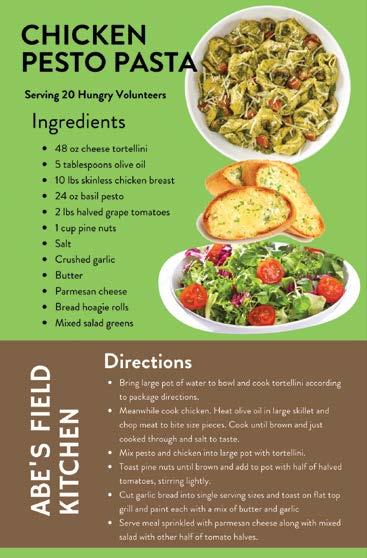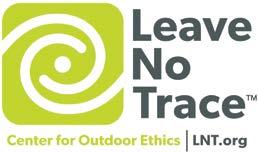
8 minute read
Feeding The Crew How Backcountry Meals Fuel and Connect Volunteers
Feeding the Crew
by Abe Christian
Advertisement
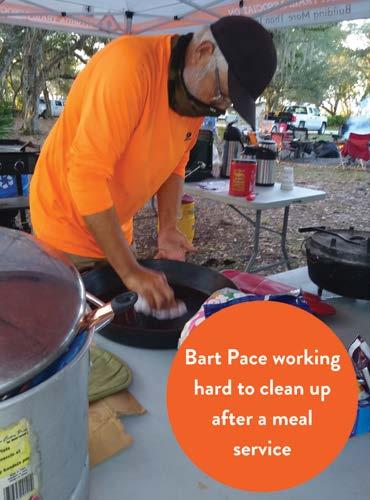
HOW BACKCOUNTRY MEALS FUEL AND CONNECT VOLUNTEERS
Prior to volunteering with the Florida Trail Association I was always fond of cooking. I never really cooked for large groups of people but when I was in middle school I really enjoyed Home Economics class. It was there that I learned how to bake by following recipe directions and being accurate with my measurements. I enjoyed it so much that I started baking muffins a couple times a month for my family. I would wake up very early and prepare everything and clean up all the dishes so when my Mom, Pop and little sister got up they would have a beautifully presented baked goods feast. At this young age, I learned that it felt amazing getting up early to prepare warm meals to serve people. While I do not wake up to make muffins on the trail, I am known for being one of the first ones up to make large batches of cowboy coffee (simple way to make bulk coffee) for all the hard working trail maintainers.
When you come out to a FTA staff lead volunteer work party we provide all the food for our hard working trail maintainers. A well-planned menu is the cornerstone of a successful food service during a FTA volunteer work party. The menu must offer a varied selection of nutritious foods that are satisfying to the volunteers. The constraints of the physical location with prep and cooking equipment available must be taken into consideration, as well as the number of people to be served, food budget, distribution of meal prep tasks, pre-cooked food on hand, meal patterns and finally, tried and true recipes. Everyday I wake up at 4am without an alarm ready to attack the day and serve others, it is usually hours before the rest of the crew. I spend that time preparing the kitchen for the day, planning out the trail work and just generally getting myself in the right mindset to have a safe and successful day. Typically, out of a group of 25 volunteers I will have two or three that also are early risers and this is a great opportunity for them to help out with preparing the morning meal.
As the menu planner considers the number of volunteers to be served, they must also consider their nutritional needs and individual preferences. People today have become more aware of new and different foods, such as vegetarian, vegan and regionally ethnic foods. Over the years of preparing large meals I have gotten some great feedback on how much the volunteers appreciate the time we take to custom make menu items around their preferences. Our Gateway Community Coordinator, Jane Pollack says, "I really appreciated having vegan-friendly options at the first work party I attended. Jeff made sure we had hearty and filling meals to fuel us through the weekend."
Planning out menus requires that the menu planner be aware of these food preferences and periodically re-evaluate the acceptance of the foods to be offered. Before a staff-led FTA volunteer work party, we poll the volunteers regarding their food preferences so that we can build a menu that caters to them. As shared by one of our volunteers, Lee Smith, “when there is a vegetarian preference, keep the meat separate from the final mix of the meal to give the volunteers an option on how much, if any, is being added to their plate.”
The number of volunteers to be served also influences the method of preparing it. Preparing suitable meals with the available equipment in any given length of time presents one of the major challenges of those responsible for planning meals. Special attention will be given to cooler capacity, burner availability and limited number of pans, cooking tools and dishes. Keeping meals to a one pot solution can reduce any obstacles or difficulties that may come up out on the trail. As one volunteer, JoAnn Rodkey says, “keep your meals simple: one pot/pan meals are preferred because they are easier to cook, as well as to clean up after.” My favorite meal is Chicken Pesto Pasta because it is easy and it is not a typical meal I make at home. I usually schedule this for the first day since the first day setup and getting situated can be a little chaotic. Having a simple meal that is tasty and filling is great, plus if there are leftovers, I have my meal for the next day's lunch already prepared!
FTA staff and crew leaders always try to minimize food costs while maximizing flavor and nutrition. Many foods can be purchased more economically in bulk from places such as Sam’s Club or Costco. However, certain types of food, such as meat proteins, can definitely impact the budget. Coming up with other ways of adding protein into a meal plan more affordably such as offering different varieties of beans, hummus, nuts, gorp and protein bars can be more cost effective. Volunteer trail maintainer Lee Smith says, “you can save money by buying less premium cuts of meat such as chicken thighs and legs instead of chicken breast.” This practice also gives the trail volunteers an added benefit by consuming the higher fat content found in dark meat which is nutritionally replenishing after a hard physical work day. Another way to economically increase the amount of food to be served is to prepare a large mixed salad and bread to be eaten with the meal or by adding more vegetables to the main dish. Linda Taylor says, “to keep meals affordable, choose recipes that include pasta, rice or beans to enhance the

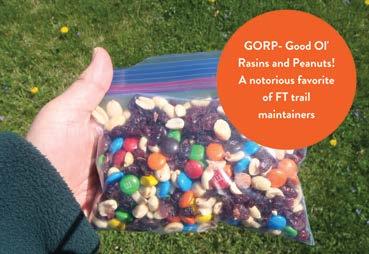
Our North Regional Manager, Jeff Glenn shopping for a big volunteer work party
meat.” Achieving a balance of affordability, quality and ease of preparation is the key to a successful food service.
The distribution of meal prep tasks is important to keep a time schedule that will help sustain the strength and morale of the team of trail volunteers. After the initial food service, a best practice for meal conversation is to talk about the next meal and start assigning tasks. Our Trail Program Director, Kelly Van Patten shared some best practices, “If we know we are making green beans with a meal, I’ll ask if anyone has a great method for cooking them, and let them take ownership. Once when I did that I found a great new way of preparing them that I use at home often– sauteeing them in cast iron with chopped up bacon and sliced onion.” Having a back-up plan for getting a meal started, should a group working in the field not get back to camp at the same time, is a necessity. Tasks for meal prep should be easy for volunteers to proactively “step-in” as needed. Most FTA kitchen kits consist of a few pots and pans, large cast iron skillets and a large double burner camp stove to make cooking for the meal service
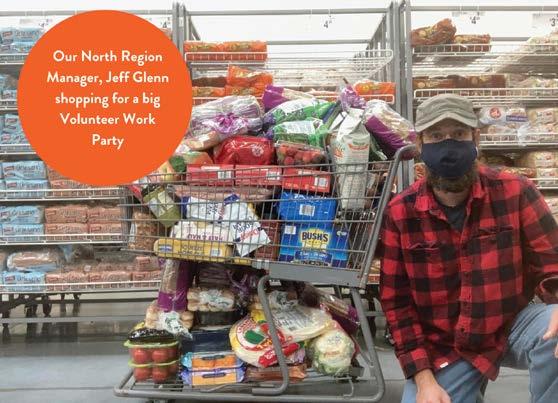


and clean-up after meal service easy. The clean-up crew is an integral part of mealtime. Not everyone strives to be a Gordon Ramsy of the Forest. If cooking isn't your favorite task, you can always help out in the kitchen by joining the clean up crew.
Some meals that have been prepared on the trail consist of appetizers or “trail tapas” such as chips & salsa, sliced cheese with crackers, pita & hummus, cut up fruits and vegetables. Breakfasts that are filling and easy such as eggs, pancakes, bacon or sausage, and oatmeal are some favorites and of course, coffee. Making sure that water and other drink choices are always readily available and accessible is extremely important for the health and endurance of each volunteer. A best practice for lunch service is to set it out as soon as breakfast has been cleared away. Having many options available for do-it-yourself sandwiches or a salad bar can be attractively presented and ingredients kept cold. Variety of choices keeps volunteers happy and healthy. With dinner we make meals like spaghetti, burritos, stir fry and pad thai. One of the favorite experiences in the Big Cypress for the volunteers is taking the long bumpy trek on the swamp buggy to camp from the Oasis that is rewarded with a large steak dinner deep in the swamp. I personally always tend to make a gigantic salad with each dinner service and it seems to be a crowd pleaser. Plus, salad and garlic bread are easy to prepare with each meal.
Well in advance, I take the time with each of my volunteer events to plan out a nutritious and satisfying menu that I have learned will work with the team. My main focus in doing this is to help create an amazing volunteer experience while helping to maintain volunteer motivation as well as a high output of trail work. I have learned that full and happy stomachs are key to this success. I look forward to many more early mornings making cowboy coffee and eating huge meals around the campfire with the team after a long day's hard work.
